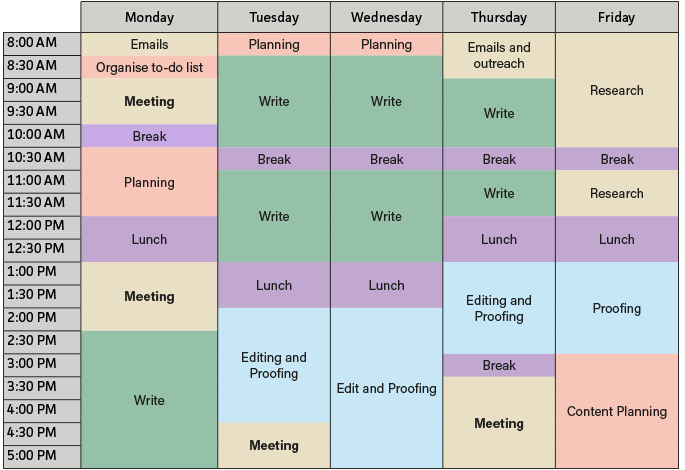One Week Time Management Plan: Three Famous Techniques
This article considers three popular time management strategies: The Pomodoro Technique, Time Blocking, and the Time Management Matrix to help you find a time management plan that works for you.
Time is your most valuable resource, if you’re not planning it, you’re wasting it.
Lost time and stress start when you don’t schedule enough time to complete a task; always give yourself more time than you think you need (top tip from Craig Jarrow, author of Time Management Ninja).

1. The Pomodoro Technique
This tomato-inspired time management technique was created in the 1980’s by Francesco Cirillo. It has a cult following of writers, developers, lawyers, and students.
The Pomodoro Technique requires you to set a timer for twenty-five minutes. You work procrastination free for twenty-five minutes, and after that, you take a short break. In your break, let your mind drift completely away from work.
This method works on the principle that attention and mental capacity work best in smaller, intense blocks of time. Pomodoro Technique lovers report less mental fatigue and greater levels of creativity.
One of the drawbacks, though, is that not all tasks should be done in 25-minute blocks.
But, as long as you’re aware of the drawbacks, there are plenty of other benefits. So it’s worth giving the technique a chance.
The Pomodoro Technique keeps you mindful of the passage of time. And it stops you from becoming a desk slug by getting much needed moments away from your screen.
If you want to get started, it’s simple.

Begin by knowing and prioritising the tasks you need to get done. Create a to-do timetable for your day or your week. For instance, Monday could look like:
- Checking emails (one Pomodoro).
- Working on a presentation (three Pomodoros).
- Writing an article (four Pomodoros).
As you work, track how many Pomodoros you need to get a task done. You’ll get more accurate as you begin to get into the groove of the Pomodoro Technique, and you’ll realise how much time you need to complete your daily tasks.
In the midst of a Pomodoro, concentrate on that task only. Prevent interruptions during that block of time. Otherwise, you’ll get that nagging guilt during your break.
As a rule, every four Pomodoros you complete mean you should take a longer break of about 20—30 minutes.
The Pomodoro Technique is good for people with ADD and ADHD. It’s also great for people with the propensity to procrastinate! Add it to your Time Management Plan, and see if it can work for you.
Need a Training Course?
Our Time Management Course teaches you all the skills you need to achieve this and organise your time effectively. You will learn how to manage your time and use your initiative to benefit both your work life and personal life.
2. Time Blocking
You know how you use a calendar to remind you that 8 pm until 9:30 pm is your beginner’s yoga class? Yeah? Well, that act of scheduling ensures you prioritise that event, that you give your full attention to it, and that you’re mentally prepared for it.
Time Blocking works on the same principal.

Time Blocking is a simple time management technique that gets you to organise your tasks into scheduled events in a calendar or spreadsheet. The idea is that you’ll be more focused and more productive if you set aside official time for the tasks you need to do.
Successful Time Blockers plan their tasks for when they’re in the right frame of mind. In other words, they plan the hardest tasks for the morning. This is when most people are feeling mentally agile. More more mechanical tasks are for the afternoon to keep you productive during the slump.
The secret to Time Blocking is knowing how and when you work well during the week.
Monday tends to be a time for low-demand tasks like organising, planning, and admin. This helps you ease out of the weekend and get back into work – ready for Tuesday and Wednesday, the peak energy days for most people.
Tuesday and Wednesday are the times for most people to tackle their most difficult tasks for the week, this is when you write, produce, brainstorm, design.
Thursday is a great day for meetings as it’s about the time when your energy starts to ebb.
Friday is a low-energy day for most. This day is for long-term planning, relationship building, and open-ended work.
Knowing when you work well allows you to better plan for it and use your time wisely.
It’s also a good idea to schedule breaks after a long block to prevent burn out!
3. Time Management Matrix
The Matrix Model was created in the late 1980’s by Dr Stephen Covey, a professor of Business at Utah State University until his death. His Matrix has survived the storm of business fads and trends and remains popular today.
If you tend to lose focus, it’s the method for you.
The Time Management Matrix method helps you figure out where to dedicate time and what to prioritise. At work, we have lots of small tasks, and they need doing. We’re all guilty of prioritising small jobs and leaving the important, long-term benefit tasks. The Matrix helps you prioritise big jobs and leave enough time for smaller day-to-day tasks.
The Matrix is a graph with four quadrants. And each quadrant divides tasks according to their urgency and importance.
Quadrant 1: Urgent and important
These tasks are your crises, pressing problems, and deadline driven projects or tasks. They have immediate consequences if they aren’t a priority.
These could be the things you neglected until last minute (making them unnecessarily urgent). Or they could be unexpected crises such as health emergencies.
Aim to stay out of this box as much as you can by making sure you don’t leave important tasks to become urgent. Neglecting long-term tasks reduces the quality of your work and increases your stress levels.

Quadrant 2: Important but not urgent
These tasks are ones with future deadlines. They could orientate around relationship building, recognising opportunities, planning or prevention. This part of the quadrant is generally for long-term development and strategising tasks. It’s the most important part of the quadrant, and you should maximise the time you spend on these tasks. Neglect these tasks and they’ll become your urgent and important tasks.
What goes in this quadrant?
These tasks, whatever they are, are they’re the recipe for your future success. Give them as much time as you can. They are the principle duties of your job, and they’re the contributions you make to drive the business forward. These are the things that if you do well, your efforts will get noticed.
Quadrant 3: Not important, but urgent tasks
These tasks need doing, but they don’t contribute to your ultimate goals. They’re the little tasks that chip away at your time and add up to a significant loss over time. These are things like emails, calls, reports and meetings.
Keep away from this quadrant as much as you can. And, if possible, delegate these tasks to those with time to do them.
Quadrant 4: Not important and not urgent
This is the quadrant where trivial tasks go. These are the things that keep you busy but have little or no value. Drop them where you can or leave them at the bottom of your priority list for downtime. These can sometimes be considered time-wasting activities – for example, dealing with annoying phone calls and emails, and organising documents, drawers, and databases.

Bad time management causes stress and anxiety; it makes those tasks you hate drag, and it stops you from doing the projects or hobbies that you really enjoy! Take control by making a time management plan today, based around your pick of the three most popular time management techniques.
If you want to have a go at the Time Management Matrix method, try filling out a Time Management Matrix today. Let us know how you get on by leaving a comment!
Click here to download your free Time Management Matrix template.








